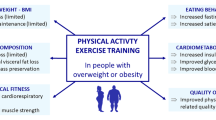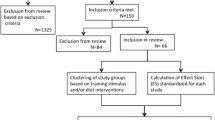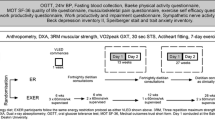Abstract
Dietary restriction combined with endurance exercise training represents an effective strategy to promote weight loss and reduce fat mass in obese patients. Exercise programmes without dietary restriction are less efficient. However, addition of exercise to a dietary restriction programme does not induce a greater fat-mass loss than dietary restriction alone. The latter is likely attributed to a compensatory reduction in daily physical activity following the implementation of exercise training. Nonetheless, inclusion of an exercise training programme is important to prevent a decrease in fat-free mass, increase relative visceral fat-mass loss, improve dietary compliance and eventually maintain long-term weight control. Obese male patients with the highest fat mass are most likely to lose the largest amount of fat mass in such lifestyle intervention programmes. Influences of training modalities during energy intake restriction on fat-mass loss are reviewed. The relationship between total energy expenditure during exercise training and overall fat-mass loss has been firmly established. The amount of training forms a more important predictor of fat-mass loss than training intensity. The sort of exercise (e.g. walking, cycling, swimming) plays another important predictor of fat-mass loss in intervention programmes. The implementation of resistance training in such programmes does not augment fat-mass loss but improves body composition by increasing fat-free mass. Further studies are needed to define the optimal interventional programme for obese patients.


Similar content being viewed by others
References
Galobardes B, Costanza MC, Bernstein MS, et al. Trends in risk factors for the major ‘life-style related diseases’ in Geneva, Switzerland, 1993–2000. Ann Epidemiol 2003 Aug; 13 (7):537–40
Chopra M, Galbraith S, Darnton-Hill I. A global response to a global problem: the epidemic of over nutrition. Bull World Health Organ 2002; 80 (12): 952–8
Chakravarthy MY, Booth FW. Eating, exercise, and ‘thrifty’ genotypes: connecting the dots towards an evolutionary understanding of modem diseases. J Appl Physiol 2004 Jan; 96 (1):
Booth FW, Olakravarthy MY, Gordon SE, et al. E. Waging war on physical in activity: using modern molecular ammunition against an ancient enemy. J Appl Physiol 2002 Jul; 93 (1): 3–30
Neel N. Diabetes mellitus: a ‘thrifty’ genotype rendered detrimental by ‘progress’. Am J Hum Genet 1962 Dec; 14: 353–62
Pronk NP. Economic aspects of obesity: a managed-care perspective. In: Andersen RE, editor. Obesity; etiology, assessment, treatment, and prevention. Champaign (IL): Human Kinetics, 2003: 33–44
American Gastroenterological Association. American Gastroenterological Association medical position statement on obesity. Gastroenterology 2002 Sep; 123 (3): 879–81
Cummings S, Parham ES, Strain GW. Position of the American Dietetic Association: weight management. J Am Diet Assoc 2002 Aug; 102 (8): 1145–55
Jakicic JM, Clark K, Coleman E, et al. Appropriate intervention strategies for weight loss and prevention of weight regain for adults: position stand of The American College of Sports Medicine. Med Sci Sports Exerc 2001 Dec; 33 (12): 2145–56
Dengel DR, Hagberg JM, Coon PJ, et al. Effects of weight loss by diet alone or combined with aerobic exercise on body composition in older obese men. Metabolism 1994 Jul; 43 (7):867–71
Lamarche B, Despres JP, Pouliot MC, et al. Is body fat loss a determinant factor in the improvement of carbohydrate and lipid metabolism following aerobic exercise training in obese women? Metabolism 1992 Nov; 41 (11): 1249–56
van Aggel-Leijssen D, Saris WHM, Hul GB, et al. Short-term effects of weight loss with or without low-intensity exercise training on fat metabolism in obese men. Am J Clin Nutr 2001 Mar; 73 (3): 523–31
van Aggel-Leijssen D, Saris WHM, Wagenmakers AJM, et al. Effect of exercise training at different intensities on fat metabolism of obese men. J Appl Physiol 2002 Mar; 92 (3): 1300–9
Ashutosh K, Methrotra K, Fragale-Jackson J. Effects of sustained weight loss and exercise on aerobic fitness in obese women. J Sports Med Phys Fitness 1997 Dec; 37 (4): 252–7
Ballor DL, McCarthy JP, Wilterdink EJ. Exercise intensity does not affect the composition of diet- and exercise-induced body mass loss. Am J Clin Nutr 1990 Feb; 51 (2): 142–6
Donnelly JE, Pronk NP, Jacobsen DJ, et al. Effects of a very low- calorie diet and physical-training regimens on body composition and resting metabolic rate in obese females. Am J Clin Nutr 1991 Jul; 54 (1): 56–61
Frey-Hewitt B, Vranizan KM, Dreon DM, et al. The effect of weight loss by dieting or exercise on resting metabolic rate in over weight men. Int J Obes 1990 Apr; 14 (4): 327–34
Geliebter A, Maher MM, Gerace L, et al. Effects of strength or aerobic training on body composition, resting metabolic rate,and peak oxygen consumption in obese dieting subjects. Am J Clin Nutr 1997 Sep; 66 (3): 557–63
Pronk NP, Donnelly JE, Pronk SJ. Strength changes induced by extreme dieting and exercise in severely obese women. J Am Coll Clin Nutr 1992 Apr; 11 (2): 152–8
Ross R, Dagnone D, Jones Pili, et al. Reduction in obesity and related comorbid conditions after diet-induced weight loss or exercise-induced weight loss in men. Ann Intern Med 2000 Jul18; 133 (2): 92–103
Whatley JE, Gillespie WJ, Honig J, et al. Does the amount of endurance exercise in combination with weight training and a very-low-energy diet affect resting metabolic rate and body composition? Am J Clin Nutr 1994 May; 59 (5): 1088–92
Miller WC, Koceja DM, Hamilton EJ. A meta-analysis of the past 25 years of weight loss research using diet, exercise or diet plus exercise intervention. In J Obes 1997 Oct; 21 (10): 941–7
Utter AC, Nieman DC, Shannonhouse EM, et al. Influence of diet and/or exercise on body composition and cardio respiratory fitness in obese women. Int J Sport Nutr 1998 Sep; 8 (3):213–22
Mayo MJ, Grantham JR, Balasekaran G. Exercise-induced weight loss preferentially reduces abdominal fat. Med Sci Sports Exerc 2003 Feb; 35 (2): 207–13
Sweeney ME, Hill JO, Heller PA, et al. Severe vs moderate energy restriction with and without exercise in the treatment of obesity: efficiency of weight loss. Am J Clin Nutr 1993 Feb;57 (2): 127–34
Nieman DC, Brock DW, Butterworth D, et al. Reducing diet and/or exercise training decreases the lipid and lipo protein risk factors of moderately obese women. Int J Obes 2002 Aug; 21(4),344–50
Lennon D, Nagle F, Stratman F, et al. Diet and exercise training effects on resting metabolic rate. Int J Obes 1985; 9 (1): 39–47
Wirth A, Vogel I, Schomig A, et al. Metabolic effects and body fat mass changes in obese subjects on a very-low-calorie diet with and without intensive physical training. Ann Nutr Metab 1987; 31 (6): 378–86
Fox AA, Thompson JL, Butterfield GE, et al. Effects of diet and exercise on common cardiovascular disease risk factors in moderately obese older women. Am J Clin Nutr 1996 Feb; 63(2), 225–33
Marks BL, Ward A, Morris DH, et al. Fat-free mass is maintained in women following a moderate diet and exercise program. Med Sci Sports Exerc 1995 Sep; 27 (9): 1243–51
Wadden TA, Vogt RA, Andersen RE, et al. Exercise in the treatment of obesity: effects of four interventions on body composition, resting energy expenditure, appetite, and mood. J Consult Clin Psychol 1997 Apr; 65 (2): 269–77
Weinstock RS, Dai H, Wadden TA. Diet and exercise in the treatment of obesity. Arch Intern Med 1998 Dec; 158 (22):2477–83
Donnelly JE, Jacobsen DJ, Jakicic IM, et al. Very low calorie diet with concurrent versus delayed and sequential exercise. Int J Obes 1994 Jul; 18 (7): 469–75
Dengel DR, Pratley RE, Hagberg JM, et al. Distinct effects of aerobic exercise training and weight loss on glucose homeostasis in obese sedentary men. J Appl Physiol 1996 Jul; 81 (1): 318–25
Hays NP, Starling RD, Kiu X, et al. Effects of an ad libitum lowfat, high-carbohydrate diet on body weight, body composition,and fat distribution in older men and women. Arch Intern Med 2004 Jan 26; 164 (2): 210–7
Hill JO, Sparling PB, Shields TW, et al. Effects of exercise and food restriction on body composition and metabolic rate in obese women. Am J Clin Nutr 1987 Oct; 46 (4): 622–30
Kempen KPG, Saris WHM, Westerterp KR. Energy balance during an 8-wk energy-restricted diet with and without exercise in obese women. Am J Clin Nutr 1995 Oct; 62 (4): 722–9
Racette SB, Schoeller DA, Kushner RF, et al. Exercise enhances dietary compliance during moderate energy restriction in obese women. Am J Clin Nutr 1995 Mar; 62 (3): 345–9
Ballor DL, Poehlman EF. Exercise-training enhances fat-free mass preservation during diet-induced weight loss: a meta analytical finding. Int J Obes 1994 Jan; 18 (1): 35–40
Bond Brill J, Perry AC, Parker L, et al. Dose-response effect of walking exercise on weight loss: how much is enough? Int J Obes 2002 Nov; 26 (11): 1484–93
Ohlsen LO, Larsson B, Svardsudd K, et al. The influence of body fat distribution on the incidence of diabetes mellitus: 13.5 years of follow-up of the participants in the study of men born in 1913. Diabetes 1985 Oct; 34 (10): 1055–8
Peiris AN, Sothmann MS, Hoffmann RG, et al. Adiposity, fat distribution, and cardiovascular risk. Ann Intern Med 1989;110: 867–72
Ross R, Rissanen J, Pedwell H, et al. Influence of diet and exercise on skeletal muscle and visceral adipose tissue in men. J Appl Physiol 1996 Dec; 81 (6): 2445–55
van Aggel-Leijssen D, Saris WHM, Wagenmakers AJM, et al. The effect of low-intensity exercise training on fat metabolism of obese women. Obes Res 2001 Feb; 9 (2): 86–96
You T, Murphy KM, Lyles MF, et al. Addition of aerobic exercise to dietary weight loss preferentially reduces abdominal adipocyte size. Int J Obes 2006 Aug; 30 (8): 1211–6
Wajchenberg BL. Subcutaneous and visceral adipose tissue: their relation to the metabolic syndrome. Endocr Rev 2000 Dec; 21 (6): 697–738
Bouchard C, Despres JP, Mauriege PO. Genetic and nongenetic determinants of regional fat distribution. Endocr Rev 1993 Feb; 14 (1): 72–93
Ballor DL, Keesey RE. A meta-analysis of the factors affecting changes in body mass, fat mass and fat-free mass in males and females. Int J Obes 1991 Nov; 15 (11): 717–26
Andersson B, Xu XF, Rebuffe-Scrive M, et al. The effects of exercise, training on body composition and metabolism in men and women. Int J Obes 1991 Jan; 15 (1): 75–81
Kennedy RL, Chokkalingham K, Srinivasan R. Obesity in the elderly: who should we be treating, and why, and how? Curr Opin Clin Nutr Metab Care 2004 Jan; 7 (1): 3–9
Elia M. Obesity in the elderly. Obes Res 2001 Nov; 9 Suppl. 4: S244–8
Glass JN, Miller WC, Szymanski LM, et al. Physiological responses to weight-loss intervention in inactive obese African-American and Caucasian women. J Sports Med Phys Fitness 2002 Mar; 42 (1): 56–64
Hill JO, Melanson EL. Overview of the determinants of overweight and obesity: current evidence and research issues. Med Sci Sports Exerc 1999 Nov; 31 Suppl. 11: S515–21
Schoeller DA. The importance of clinical research: the role of thermogenesis in human obesity. Am J Clin Nutr 2000 Mar; 73(3),511–6
Zurlo F, Ferraro RT, Fontvielle AM, et al. Spontaneous physical activity and obesity: cross-sectional and longitudinal studies in Pima Indians. Am J Physiol 1992 Aug; 263 (2 Pt 1): E296–300
Weinsier RL, Hunter GR, Desmond RA, et al. Free-living activity energy expenditure in women successful and unsuccessful at maintaining a normal body weight. Am J Clin Nutr 2002 Mar; 75 (3): 499–504
Blundell JE, King NA. Effects of exercise on appetite control: loose coupling between energy expenditure and energy in take. Int J Obes 1998 Aug; 22 Suppl. 2: S22–9
Blundell JE, Stubbs RJ, Hughes DA, et al. Cross talk between activity and appetite control: does physical activity still at appetite? Proc Nutr Soc 2003 Aug; 62 (3): 651–61
Westerterp KH. Obesity and physical activity. Int J Obes 1999 Feb; 23 Suppl. 1: S59–64
Ravussin E, Lillioja S, Knowler WC, et al. Reduced rate of energy expenditure as a risk factor for body-weight gain. N Engl J Med 1988 Feb; 318 (8): 467–72
Byrne HK, Wilmore JH. The effects of a 20-week exercise training program on resting metabolic rate in previously sedentary, moderately obese women. Int J Sport Nutr Exerc Metab 2001 Mar; 11 (1): 15–31
Racette SB, Schoeller DA, Kushner RF, et al. Effects of aerobic exercise and dietary carbohydrate on energy expenditure and body composition during weight reduction in obese women. Am J Clin Nutr 1995 Mar; 61 (3): 486–94
Zurlo F, Lillioja S, Esposito-Del Puente A, et al. Low ratio of fat to carbohydrate oxidation as predictor of weight gain: study of 24-h RQ. Am J Physiol 1990 Nov; 259 (5Pt 1): E650–7
Hainer V, Kunesova M, Parizkova J, et al. Respiratory quotient in obesity: its association with an ability to retain weight loss and with parental obesity. Sb Lek 2000; 101 (1): 99–104
Nicklas BJ, Rogus EM, Goldberg AP. Exercise blunts declines in lipolysis and fat oxidation after dietary-induced weight lossin obese older women. Am J Physiol 1997 Jul; 273 (1 Pt 1):E149–55
Gan SK, Kriketos AD, Ellis BA, et al. Changes in aerobic capacity and visceral fat but not myocyte levels predict increased insulin action after exercise in overweight and obese men. Diabetes Care 2003 Jun; 26 (6): 1706–13
Goodpaster BH, Katsiaras A, Kelley DE. Enhanced fat oxidation through physical activity is associated with improvements in insulin sensitivity in obesity. Diabetes 2003 Sep; 52 (9): 2191–7
Pasman WJ, Westerterp MS, Saris WH. The effect of body weight changes and endurance training on 24h substrate oxidation. Int J Obes 1999 Dec; 23 (12): 1223–32
Kanaley JA, Weatherup-Dentes MM, Alvarado CR, et al. Substrate oxidation during acute exercise and with exercise training in lean and obese women. Eur J Appl Physiol 2001 Jul; 85(1–2),68–73
Wahrenberg H, Lonnqvist F, Arner P. Mechanisms underlying regional differences in lipolysis in human adipose tissue. J Clin Invest 1989 Aug; 84 (2): 458–67
Mandroukas K, Krotkiewski M, Hedberg M, et al. Physical training in obese women: effects of muscle morphology, biochemistry and function. Eur J Appl Physiol Occup Physiol 1984; 52 (4): 355–61
Krotkiewski M, Bylund-Fallenius AC, Holm J, et al. Relationship between muscle morphology and metabolism in obese women: the effects of long-term physical training. Eur J Clin Invest 1983 Feb; 13 (1): 5–12
Segal KR, Edano A, Abalos A, et al. Effect of exercise training on insulin sensitivity and glucose metabolism in lean, obese, and diabetic men. J Appl Physiol 1991 Dec; 71 (6): 2402–11
Mauriège P, Després JP, Prud’Homme D, et al. Regional variation in adipose tissue lipolysis in lean and obese men. J Lip Res 1991 Oct; 32 (10): 1625–33
De Glisezinski I, Crampes F, Harant I, et al. Endurance training changes in lipolytic responsiveness of obese adipose tissue. Am J Physiol 1998 Dec; 275 (6 Pt 1): E951–6
Leutholtz BE, Keyser RE, Heusner WW, et al. Exercise training and severe caloric restriction: effect on lean body mass in the obese. Arch Phys Med Rehabil 1995 Jan; 76 (1): 65–70
Jeffery RW, Wing RR, Sherwood NE, et al. Physical activity and weight loss: does prescribing higher physical activity goals improve outcome? Am J Clin Nutr 2003 Oct; 78 (4): 684–9
Gwinup G. Weight loss without dietary restriction: efficacy of different forms of aerobic exercise. Am J Sports Med 1987; 15(3), 275–9
Lazzer S, Bairie Y, Meyer M, et al. Evalution of two foot-to-foot bioelectrical impedance analysers to assess body composition in overweight and obese adolescents. Br J Nutr 2003; 90:987–92
Perri MG, Anton SD, Durning PE, et al. Adherence to exercise prescriptions: effects of prescribing moderate versus higher levels of intensity and frequency. Health Psychol 2002 Sep; 21(5), 452–8
Davis JA, Vodak P, Wilmore JH, et al. Anaerobic threshold and maximal aerobic power for three modes of exercise. J Appl Physiol 1976 Oct; 41 (4): 544–50
Achten J, Venables MC, Jeukendrup AE. Fat oxidation rates are higher during running compared with cycling over a wide range of intensities. Metabolism 2003 Jun; 52 (6): 747–52
Stiegler P, Cunliffe A. The role of diet and exercise for the maintenance of fat-free mass and resting metabolic rate during weight loss. Sports Med 2006; 36 (3): 239–6
van Etten MLA, Westerterp KR, Verstappen FTJ, et al. Effect of an 18-wk weight training program on energy expenditure and physical activity. J Appl Physiol 1997 Jan; 82 (1): 298–304
Skinner J, McLellan T. The transition from aerobic to anaerobic metabolism. Res Q Exerc Sport 1980 Mar; 51 (1): 234–48
Bryner RW, Ullrich IH, Sauers J, et al. Effects of resistance vs. aerobic training combined with an 800 calorie liquid diet on lean body mass and resting metabolic rate. J Am Call Clin Nutr 1999 Apr; 18 (2): 115–21
Acknowledgements
We would like to thank Dr Massa Guy for his kind assistance in reviewing this article and offering textual suggestions.
No sources of funding were used to assist in the preparation of this review. The authors have no conflicts of interest that are directly relevant to the content of this review.
Author information
Authors and Affiliations
Corresponding author
Rights and permissions
About this article
Cite this article
Hansen, D., Dendale, P., Berger, J. et al. The Effects of Exercise Training on Fat-Mass Loss in Obese Patients During Energy Intake Restriction. Sports Med 37, 31–46 (2007). https://doi.org/10.2165/00007256-200737010-00003
Published:
Issue Date:
DOI: https://doi.org/10.2165/00007256-200737010-00003




